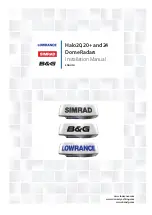
20
21
-0
6
12
Level Radar LCR20
Measuring principle
4
Measuring principle
The device is a "downward-looking" measuring system, which functions according to the time-
offlight (ToF) method. It measures the distance from the reference point
R
to the product
surface. Radar pulses are emitted by an antenna, reflected off the product surface and
received again by the radar system.
Figure 4.1
Setup parameters of the device
4.1
Input
The reflected radar pulses are received by the antenna and transmitted to the electronics.
A microprocessor evaluates the signals and identifies the level echo caused by the reflection
of the radar pulses at the product surface. This clear signal detection system benefits
from over 30 years' experience with time-of-flight procedures.
The distance
D
to the product surface is proportional to the time of flight
t
of the pulse:
D = c x t/2,
where
c
is the speed of light.
Based on the known empty distance
E
, the level
L
is calculated:
L = E – D
4.2
Output
The device is calibrated by entering the empty distance
E
(= zero point) and the full distance
F
(= span).
•
Current output: 4 to 20 mA
•
Digital output (HART, P+F Level): 0 to 15 m (0 to 49 foot) or 0 to 20 m (0 to 66 foot)
depending on antenna version
E
Empty calibration (= zero)
F
Full calibration (= span)
D
Measured distance
L
Level (L = E - D)
Q
Flow rate at measuring weirs or channels (calculated from the level using linearization)
R
Reference point
D
Q
R
100%
0%
D
L
F
E
Содержание LCR20
Страница 1: ...ISO9001 LCR20 HART Level Radar Technical Information...
Страница 6: ...2021 06 6 Level Radar LCR20 Contents...
Страница 69: ...Level Radar LCR20 Notes 2021 06 69...













































